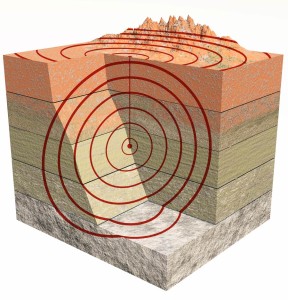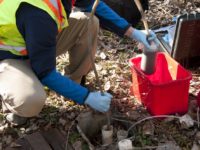
Seismology is the study of seismic waves, energy waves caused by rock suddenly breaking apart within the earth or the slipping of tectonic plates. We know these as events as earthquakes. They can also be caused by explosions from volcanic eruptions and testing of nuclear bombs. Seismology also studies seismic waves deliberately induced by controlled explosions, large trucks, and construction equipment, usually to search for underground sources of petroleum and natural gas.
Seismologists study earthquakes and their results, like tsunamis, and landslides. They may also monitor active volcanoes for tremors and signs of an impending eruption. They use seismographs and computer equipment to collect and analyze data on seismic events.
What Does a Seismologist Do?
Most seismologists work in petroleum exploration where they plan, generate, monitor, and analyze controlled seismic waves from explosions and vibrations from trucks. The information collected from the waves' movement and interactions with underground features help seismologists determine where oil and gas may be found.
Other seismologists study natural seismic waves related to hazards like earthquakes and volcanos, as well as their results, such as tsunamis and landslides. Some try to figure out why they last a certain amount of time, and how they stop. Some seismologists focus on geologic faults. They attempt to evaluate future risk and predict future destructive events. Their work helps protect the public through preparation, advisories, seismic zoning, and earthquake engineering. Maps of affected areas provided by seismologists can also help relief efforts after catastrophic events.
A few seismologists monitor for underground nuclear test explosions for intelligence agencies. Some use their knowledge to help unearth archaeological sites. Others conduct more theoretical research on the geological makeup and structures of the Earth.
Most seismologists plan and conduct field studies, where they collect samples and conduct site surveys. They then test the samples they collect in the lab. They also analyze air photos, well logs (geological notes made during drilling), rock samples, and other data to locate and assess underground oil and mineral resources. They make geologic maps, write reports, and present their findings to clients and colleagues.
Where Does a Seismologist Work?
Most seismologists, and 26% of geoscientists as a whole, are employed in oil and gas extraction. While the U.S. Bureau of Labor Statistics (BLS) doesn't report on seismologists specifically, it reports that another 16% of geoscientists were employed in engineering services as of 2012. 12% of geoscientists provided management, scientific, and technical consulting services. 7% worked in state government, and another 7% were employed by the federal government.
Seismologists studying large earthquakes often work in observatories or analysis centers with hyper-computing capabilities. These are usually run or supported by national governments. Smaller earthquakes are analyzed at regional research centers tied to university or government laboratories.
Most seismologists work full time and maintain a standard work week. However, long or irregular hours may be required when doing fieldwork, or during public emergencies caused by seismic events. They may need to travel often to reach field work sites, which can be sometimes be rustic.
What Is the Average Seismologist Salary?
BLS reports the average annual wage for geoscientists as a whole was $93,580 as of May 2020. Those employed in oil and gas extraction earned the highest median salary at $125,670, followed by those working in the federal government, at $104,210.*
Seismologist Jobs & Job Description
Seismologist careers match the study of the Earth with the study of physics to research and apply the creation and continuation of energy transferred through the Earth's materials. The overall aim is to interpret the composition and structures of the earth as well as evaluate potential dangers. While seismologist jobs do vary considerably, many of the below tasks are common to all jobs:
- Analyze and interpret seismic data to categorize different sources - such as the difference between an earthquake and an explosion
- Use data sets to evaluate hazards
- Review research and literature relating to current discoveries in the field
- Provide evaluative reports to governments, engineering companies or other external stakeholders
- Use computers to model information, gain insight for possible hypotheses, and predict trends
- Use modelling data to construct models of the Earth's subsurface
- Use data to produce maps of seismic activity and intensity after an earthquake
- Develop methodologies to improve upon conventional interpretation approaches, including writing new computer algorithms to manipulate data
- Communicate with the media and public to educate people about earthquakes and earthquake preparedness
- Inform critical infrastructure, emergency response groups and the media when large earthquakes have occurred
- Write scientific reports and publish study findings
- Incorporate site characteristics like soil effects into data collection
- Apply knowledge of secondary perils such as tsunami, liquefaction and landslides
- Understand vulnerability analysis and processing of large damage datasets to develop custom damage predictions
- Perform detailed statistical and data analysis for risk analysis
- Preparing documentation and reports showing the results of the analysis, to be included in the R&D presentations to clients
- Familiarity with insurance regulations and decision-making models
- Be able to deploy earthquake hazard catastrophe model development
- Excellent understanding of the USGS earthquake hazard program.
Senior seismologists are often promoted to manage a team or teams in the field or in the lab. Such responsibilities often include:
- Actively collaborate with software development teams for model development and implementation
- Foster a positive and safe work environment for mentor relationships and colleagues
- Develop and report on project scopes, schedules, and budgets
- Prepare technical reports; liaise with site stakeholders
- Supervise fieldwork (survey, site recording, testing, monitoring, and data integrity) of multiple field crews
- Communicate with funding agencies through grant applications
- Communicate with stakeholders through field status reports and presentation of team findings
- Oversee equipment and instruments
Ensure data integrity, quality assurance, organization, and appropriate tracking
What Is the Job Demand for Seismologists?
Employment of geoscientists overall is projected to grow 7 percent between 2020 and 2030.* Exploration for oil and gas, new drilling techniques, hydraulic fracturing, and increased interest in the environment will partly drive this growth. Geoscientists with master's degrees will have the best opportunities.
How Do I Get a Seismologist Degree?
Seismology is a field of geophysics. Most students earn bachelor's degrees in geophysics, geology, physics, or math. Geology, physics, math, and computer science are all important areas of study for future seismologists.
Advanced degrees are important for research positions. Most require a Ph.D. There are few graduate programs in geophysics; master's students typically study geology or physics.
Other Degrees Related to Seismology
What Kind of Societies and Professional Organizations Do Seismologists Have?
- The Seismological Society of America (SSA) is an international professional association founded in 1906. It organizes an annual meeting, publishes Seismological Research Letters and the Bulletin of the Seismological Society of America, and funds awards.
- The American Geophysical Union (AGU) is an important professional organization for geophysicists and seismologists. It publishes several peer-reviewed journals, organizes the AGU Digital Library, offers workshops and webinars, and hosts a career center.
- At over 100 years old, the Geological Society of America (GSA) is the foremost professional association for geologists of all stripes. It has 18 divisions, including one for Environmental and Engineering Geology. It also organizes networking opportunities through geoscience travel and tours.
*2020 US Bureau of Labor Statistics salary figures and job growth projections for geoscientists reflect national data not school-specific information. Conditions in your area may vary. Data accessed September 2021.





